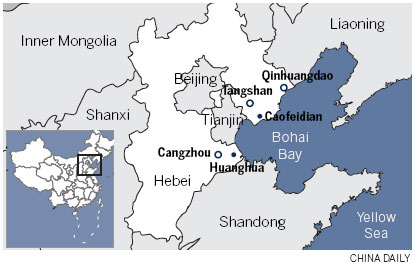Ports will help bring new tide of prosperity
Updated: 2012-12-11 09:01
By Wang Hao, Du Juan and Pei Pei (China Daily)
|
|||||||||||
A vision from the past takes concrete shape to secure the future, Wang Hao, Du Juan and Pei Pei report in Tangshan and Cangzhou, Hebei province.
'A great port will be built in northern China. It is my and my compatriots' idea to develop the port in a limited amount of time and make it as big as New York," says a line in Methods and Strategies of Establishing the Country, published in February 1919.
The author of those words was the revolutionary Sun Yat-sen (1866-1925), who wrote the Methods seven years after he declared the founding of the Republic of China and became its first president. At the time, China was divided by warlords and hard-pressed by poverty, but still Sun envisioned the port and detailed its location.
|
 |
|
Infrastructure development is sparking an upturn in the economy at Caofeidian, an emerging industrial zone in Hebei province.[Photo/Xinhua] |
More than 100 km south of Caofeidian, also on the coast of Bohai Bay, Huanghua Port, built in 1984, has emerged as China's second-largest coal exporting port. Its expansion has been rapid because Shenhua Group Co, China's biggest coal producer, has spent the past decade building its own port in Huanghua.
The two rapidly expanding ports are expected to be the drivers of an economic takeoff in Hebei, which encircles Beijing and Tianjin. The populous province provides the two municipalities with numerous resources and helps to shoulder their development costs.
The ports are also a demonstration of China's progress in the field of sustainable development. Projects, such as Shougang United Iron and Steel Co, which moved to Caofeidian from suburban Beijing ahead of the Beijing Olympics in 2008, have embraced the concept of the "circular economy" for the benefit of the environment.
Wang Zhongmin, general manager of Tangshan Caofeidian Shiye Port Co Ltd, has worked at the port for nine years. "I arrived when the infrastructure construction for the port began at the end of 2003. Soon, we were building a port for iron ore. It was urgently needed," he said.
 At Caofeidian, five or six cargo vessels, each with the capacity to carry 200,000 metric tons of iron ore, are unloaded every day.
At Caofeidian, five or six cargo vessels, each with the capacity to carry 200,000 metric tons of iron ore, are unloaded every day.
Analysts believe that the port's location means it has more advantages and greater potential than Qinhuangdao.
In 2011, construction was completed on the first and second phrases of iron ore ports, the first phrase of a coal port, crude oil and bulk terminals with a total turnover volume of 170 million tons, according to the Caofeidian local government.
The port will have a capacity of 300 million tons and turnover volume of 200 million tons by the end of the year, said Yang Jie, chief executive of Caofeidian district.
Yang said the port will eventually reach a total capacity of 500 million tons, becoming one of the largest ports in the world, when the projects are completed. Coal is the most important of the projects because of its impact on the energy supply in Southeast China.
Related Stories
Hebei ranks top in port construction among coastal provinces 2012-12-10 13:42
China's largest inland port aspires to be trade hub 2012-11-27 15:20
Port’s handling capacity of Hebei Port Group goes above 300 million tons 2012-11-16 15:12
Today's Top News
President Xi confident in recovery from quake
H7N9 update: 104 cases, 21 deaths
Telecom workers restore links
Coal mine blast kills 18 in Jilin
Intl scholarship puts China on the map
More bird flu patients discharged
Gold loses sheen, but still a safe bet
US 'turns blind eye to human rights'
Hot Topics
Lunar probe , China growth forecasts, Emission rules get tougher, China seen through 'colored lens', International board,
Editor's Picks

|

|

|

|

|

|





